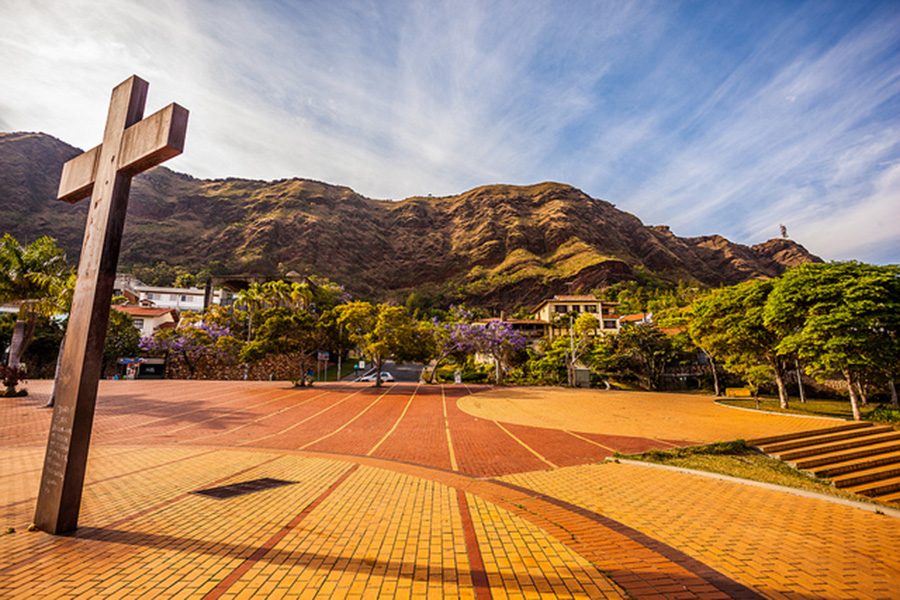The front door open in the houses, unconcerned. The friendly and receptive people. Framing all this, the mountainous landscape that dispenses descriptions. The Hidromineral Resort of Águas da Prata mixes ecotourism, adventure tourism, rural tourism, historical, gastronomic, cultural and religious. Several itineraries are available in the region that divides São Paulo from Minas Gerais.
Faith on the Path
The Association of Friends of the Path of Faith, as the name suggests, provides volunteer services to the thousands of walkers from the Path of Faith, the largest pilgrimage route in the Americas, which has Águas da Prata as its route. The route was inaugurated in 2003, inspired by the Camino de Santiago de Compostela, Spain. Annually, about 9 thousand pilgrims leave Águas da Prata for the Way of the Faith and about 25 thousand people pass through the city with the same objective.
Almir Grings is the creator of the project: “There is no special reason for the pilgrim, the beauty of the path justifies the challenge. Moreover, those who travel the route (more than 400 km in total), have the opportunity to observe nature, spend days or weeks living only with the essentials and mainly reflect and meditate during the course, “says Grings.
Pico do Gavião
On the road traveled by pilgrims from the Way of the Faith, with a slight detour, it is worth passing through the Gavião Peak, which, with almost 1,700 meters of altitude, is a reference in the practice of free flight. The peak is located at the same time in São Paulo and Minas Gerais, more precisely in Águas da Prata (SP) and Andradas (MG) and allows adventurers to practice, besides free flight, mountain biking, slackline, trails and camping. A tip for anyone going to Pico do Gavião is to stop at one of the more than ten waterfalls located on the steep path to the place.
Sao Joao da Boa Vista
In addition to Águas da Prata, two neighboring cities were part of the route, São João da Boa Vista (SP) and Andradas (MG). Attracted by the range of possibilities and types of tourism (historical, rural, adventure, among others), the cities on the border of São Paulo and Minas Gerais were important stage during the Revolution of 32. This historical event is still used today for the creation of walking circuits through the trenches of the civic movement.
Historical Tourism – Revolution of 32
After the collapse of the politics of the coffee with milk and the taking of power by Getúlio Vargas in 1930, forces forming supporters and opponents of the government were formed, until, on May 23, 1932, the groups clashed in the streets of Sao Paulo, resulting in the death of students, who became known as MMDC (initials of the names of young people killed in the conflict).
The deaths are the fuse that start, on July 9 of the same year, to the movement. With the borders of São Paulo and Minas Gerais as an active stage of the conflicts, there are still vestiges of the battles that have become historical routes for tourists visiting the region.
Education and Culture
We were guided by the calm streets of São João, with the old constructions and the tranquility of the passers-by. San Juan’s traffic education is an example for the drivers of large metropolises. In the square, next to the church, stands the Municipal Theater Sanjoanense, which completed one hundred years on October 31 last year and has the doors open to the public and various types of art.
São João da Boa Vista presents the visitor with a variety of museums, churches, restaurants, some hotels, but what can not miss during the visit is the São João Batista cemetery.
The cemetery is an open air museum. The most famous works are the artist Fernando Furlanetto: realistic marble sculptures with sacred figures commissioned for church altars and cemetery tombs.
Andradas
Andradas, in Minas Gerais, is known for being the city that produces the most roses in Brazil. The municipality also attracts visitors for the variety of adventure tourism options. In addition to the Gavião Peak, Andradas has radical reliefs for climbing, such as the Elephant Stone or the Pedra da Cruz, for example. Combined with climbing, it is common to practice trekking in the city.
Wineries
Another attraction in the region are the wineries, both artisan and industrial. Highlight for the Geraldo House, of industrial size, which besides producing wine has shop and restaurant.
Our itinerary through the city ended in another attraction that is worth visiting: the Basso Winery, founded in 1902, still remains handmade, with wooden barrels and reduced production, preserving the tradition. There, Rogério Basso, who today takes care of the establishment with the help of his uncle, tells visitors the history of the winery, explaining why they still maintain the traditional means of production.
Photo: Reproduction
Source: DailyTourism

